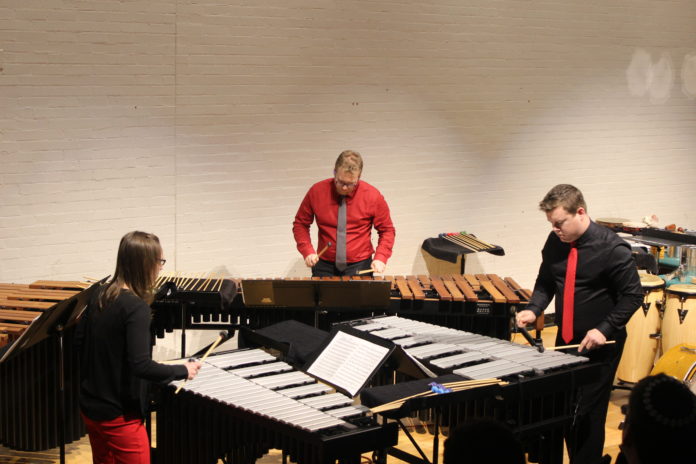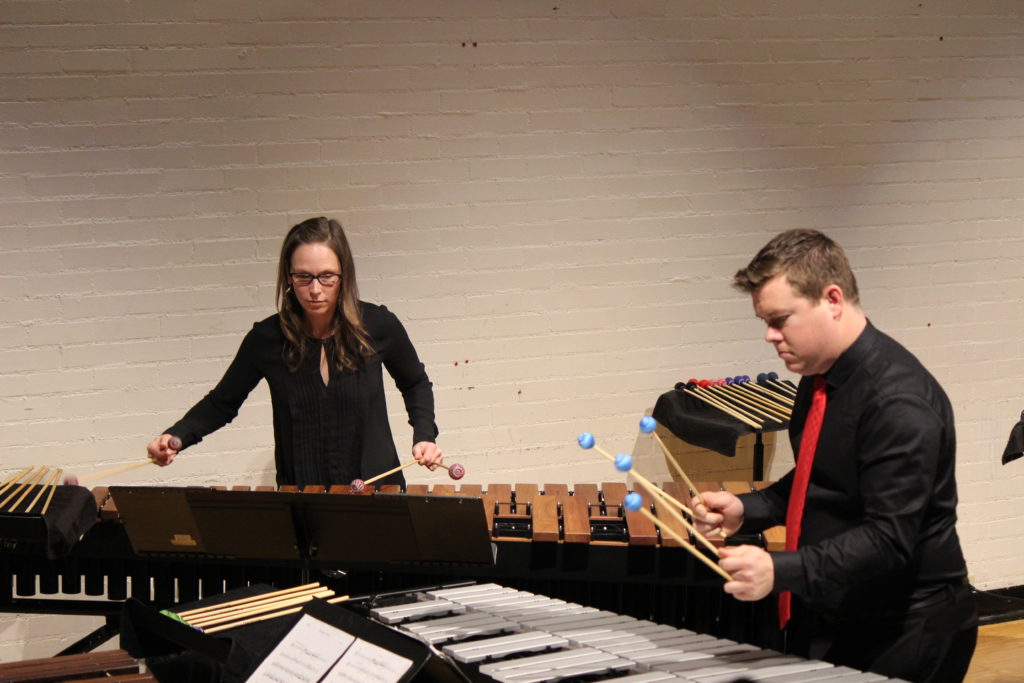
Imagine if you could be forever in time, in rhythm, in beat, in pattern with the world around you; in time to such a point that you find yourself no longer counting but instead being, and for some, creating. This is only partially the emotions I felt while watching the touring group Clocks in Motion perform on Muhlenberg’s campus last week. Described as a percussionist ensemble, the group was formed in 2011 in Madison, Wisconsin. Originally they were larger, having up to twelve ensemble members in order to perform the enormous repertoire of some older percussion pieces. As time went on however, the group shrunk, and shifted towards a different approach to their art.
‘Different,’ however, is not the best word to use to describe this music. It’s more complex than that. Their opening piece, Mark Mellits’ “Gravity,” is a good place to start.
Featuring marimbas, vibraphones, and other various percussion instruments, the piece began with a fast start. Using various mallets to create certain soundscapes, the composition grew in tension through the rhythms as well as the harmonies. It was hard to breathe with how thick the texture they created was. Shifting from singular mallets in each hand to two at a time, the goal of the piece was undeniably atmosphere—and all that applies with such a word. The rise and fall of pressure, the weightlessness, the heaviness, space, and the constriction. For me, it was experiencing an entirely new sound pallet—but how does one describe this in mere writing?
The important thing about the contemporary music festival is creating that space where we can experience all of these different types of music that are of our time but maybe are wildly different from one another.
Well, then there is the virtuosity in question. Performers Matthew Coley, Chris Jones, Sean Kleve, and Megan Arns demonstrated mastery over their craft. As they jumped and twisted from placement musically to placement physically, perfectly in sync with one another mind, the piece only seemed to grow in complexity and wonder. I couldn’t turn away—visually or otherwise.
The next piece I want to mention is John Cage’s “Third Construction.” Explained as the oldest piece in their repertoire that night, the composition consisted a series of not only drums but soup cans, symbols, shakers, wood blocks, and even a conch shell. This was mainly due to the piece’s construction at the time. Percussion instruments were (and still are) expensive, so Cage found and used what he could to create the piece he had in his head. Due to this, he couldn’t find any percussionists to play his piece as a majority of them wished to stick to classical repertoire. Because of this, the piece was performed by mainly dancers and pianists.
It was my personal favorite as well, honestly. The composition is just extravagant in both its instrumentation and score. While to some it may have seemed improvised and almost random, Kleve asserts that not a single aspect of “Third Construction” is improvised. Every part, rhythm, and sound is played intentionally at a specific time and place. Specifically to demonstrate its namesake, ‘construction.’
“I don’t know that I have ever heard John Cage’s “Third Construction” live before…” Dr. Andrew Ardizzoia lamented, “that piece struck me because it is so wild…We think of John Cage as a sort of…calm a tranquil guy, but the early stuff is so rhythmically vital. It has such vivacity to it.”
As the coordinator of the Contemporary Music Festival, Dr. Ardizzoia had an idea of what he wanted demonstrated and expressed throughout his program.
“We have a very strong choral program. We have a strong instrumental program. Most of the programing in those two areas is devoted to music that is a little bit older…” Dr. Ardizzoia explained, “what we do with the contemporary music festival intends to be a little bit more on the beaten path in terms of its accessibility.”
Dr. Ardizzoia then continues to explain part of the festival’s primary goal is to play and share music of living composers as well as composers who encompass a variety of genres. Including such repertoire as Clocks in Motion.
“The important thing about the contemporary music festival is creating that space where we can experience all of these different types of music that are of our time but maybe are wildly different from one another,” Dr. Ardizzoia continues, “that’s one of my goals with the contemporary music festival; to make sure we’re representing a diverse range of both composers with diverse aesthetic outlooks and also performers who are interested in a lot of different things.”
Dr. Ardizzoia also stressed the value of diverse repertoire in the festival—diversity in a sense that is both in tangent and seperate from the classics that we have all come to know and love.

Megan Arns (left) and Christopher G. Jones (right) perform with two mallets in each hand. Cole Geissler / The Muhlenberg Weekly
“To me the diversity is a really important part of what we do. If we had a mission, I think diverging aesthetic view points would be really important part of what we’re talking about.”
Clocks in Motion also featured the work of Jennifer Bellor, a composer who is currently writing for their ensemble group. Her piece, Of Maker & Movement, was a composition of three movements.
“I thought Jennifer Bellor’s piece was the strongest on the program—just in terms of the surface level sounds that she’s working with. She has such an ear for timbre,” said Dr. Ardizzoia.
The production was a success. Truly outstanding and one of a kind in nature. The festival of course continues with its next ensemble Atlemos. Be sure not to miss it Mar. 29 in the Recital Hall of the Center for Arts.
“The program alone is enough to make people sort of sit up and take notice—but it is also going to be performed at such a high level,” Dr. Ardizzoia continued, “I think you would be silly not to be there if you have any interest in singing, wind instruments, chamber music, any of that sort of thing. It’s going to be a great day.”





















